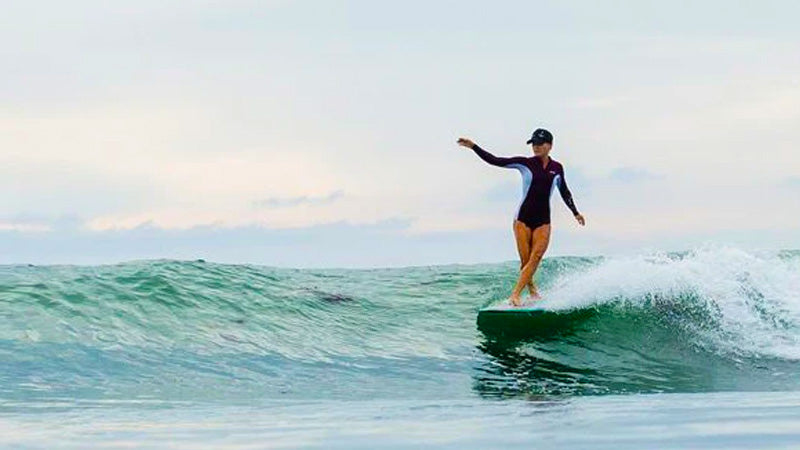
When to surf with a longboard?
One of the best feelings in the world is longboarding with friends. Longboard sessions are usually "chill" and "relaxed" ( unless you are a charger ). Learning to longboard is much easier than learning on a shortboard… The reason being is the surface area; on a longboard, you have about 40% more surface to find your balance on because of its size, stability and float ability.
Normally used on smaller waves, you get to catch much more of them and far behind the shoartboarders so you have a longer time on the wave. At the end of the day with all those factors combined: you’re just plain able to surf more while on a longboard.
They are the perfect board for the very beginners to surf with but that doesn't mean pros won't surf on a longboard in small and bigger waves. It simply is a different style of surfing giving as much satisfaction as a shortboard, it only depends on what you are willing to do. Theses board happens to be perfect for beginners to learn to surf, this is why people sometimes say longboards are beginner's boards, Which is not true at all.

First... A little bit of history!
Even if the origin of surfing is generally agreed around the world, the timeline is still a little vague. Back in the days, the Polynesians were the first to discover this amazing connection with the ocean that we call surfing. They created boards from wood. They use to build boards that today we call "olo boards" without knowing these pieces of woods would be the main inspiration to the "moderns longboards".The Polynesian creation of surfing symbolizes their connection with the ocean, their desire to be one with the waves.

What is a longboard?
A longboard is usually between 8-12 foot long and are the best option if you want to be able to surf year-round. Because of their size, great floatation and glide, they make tiny 1-2 feet days actually really fun!
Usually, we recommend people to begin their surfing adventure with a longboard or a funboard. The reason is it is easier to start with floatable boards which is the case of a longboard and a softboard. They usually have a lot of volume and float ability.Volume is the most important factor when choosing surfboard for a beginner. A board with lots of volumes will float better which makes it easier for learners to get to their feet and generate enough speed while paddling to catch the waves. Volume is usually measured in litre. We think a great beginner surfboard should have at least 60 litres of volume
At the Billy store, we often have people coming from a snowboard, kiteboard or other boardsports background and think they can skip the "beginner phase" but most of the time these people are wrong and lose a lot of time trying to surf instead of actually having the feeling and learning the right way.
They are commonly single fin or 2+1 ( A long one in the middle and two smaller side fins ).

Who is longboarding made for?
Longboards are made for people that want to enjoy the ocean, have a great feeling without struggling too much with paddling and balance. That said, you can bring your longboard to a gnarly spot and find as much adrenaline as you would have surfing shortboards.
A longboard will easily generate speed from paddling therefore you will be able to stand up and surf the waves very early when they are not too steep yet. Once up on the board, you will not need to pump or look for the right spot to keep that speed, if you have a good line and good enough waves, your focus can be elsewhere such as walking on the board or do other longboard manoeuvres.
It is a slower, mellower and usually smaller waves kind of surfing.
Surfing with a longboard will take you to more waves than with a shortboard and therefore you'll get better learning on the mechanics of the wave.
Beginners also should always start with a longboard, it is what will offer them the best experience when you go out there for the first time. ( the hassle outside the water is a little bigger because of the size of the board but to actually learn to surf, they are the best boards! )

What kind of waves a longboard is good for?
It is definitely true that there are surf breaks better for longboards than shortboards but it aslo goes all the way around.
The ones that are not: waves that are fast, hard, hollow and in shallow water. ( like Pipeline, Teahupoo, Supertubos for instance )
The ones that are: waves that are slow, longer and are often smaller in height. ( knee to chest high )
Ideal conditions:
- 1-6 ft range
- Slower, easy breaking, crumbly waves
- Lined up points or reefs with a channel
Plus and Minus of a longboard:
Plus:
- Easy to catch waves
- Easy to paddle
- Very stable
- You can still surf on the smallest of days
Minus:
- Big and fragile, Difficult to travel with.
- Can’t duck dive
- Harder to manoeuvre (unless you’re experienced)
- Expensive
Conditions:
- 1-6 ft range
- Slower, easy breaking, crumbly waves
- Lined up points or reefs with a channel
Our selection of funboards right here! 
Thanks for reading us and hope to see you at the line up very soon!
